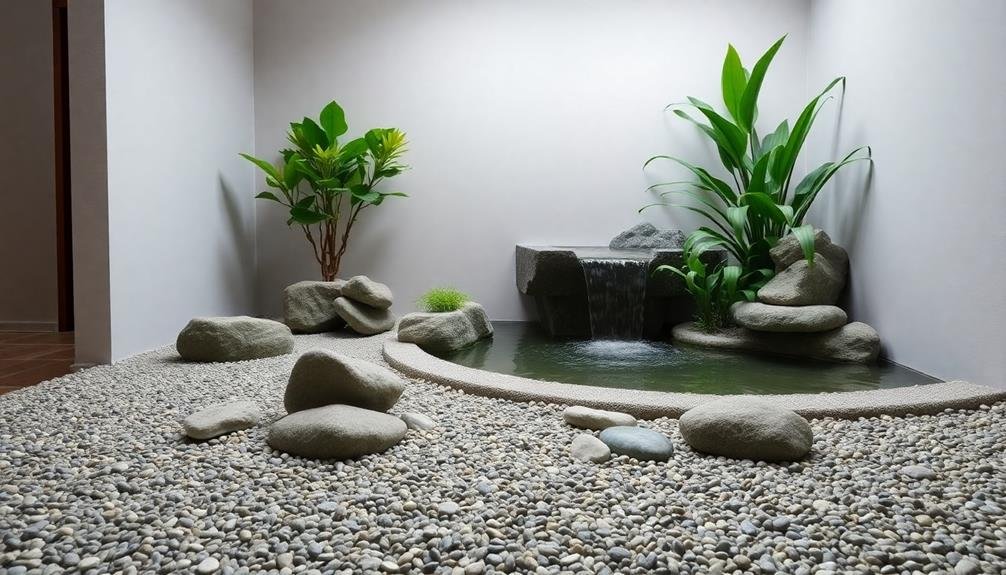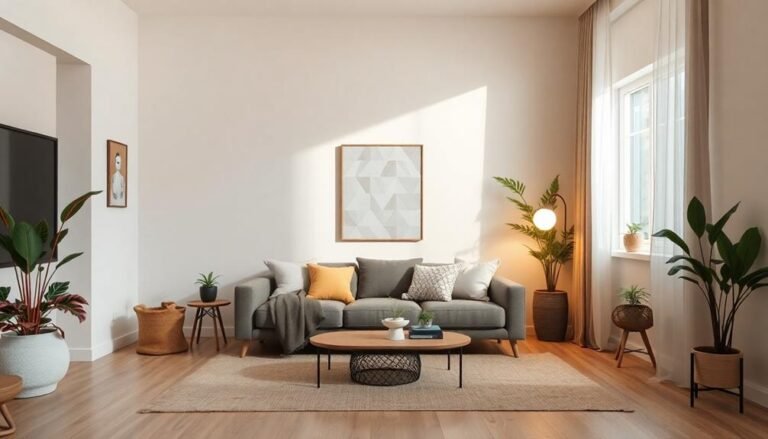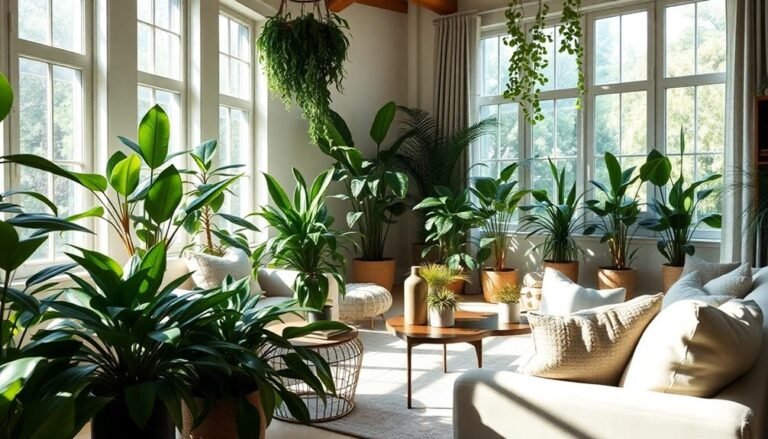Creating a Zen garden or an indoor water feature can transform your space into a peaceful retreat that promotes calm and mindfulness. Start with natural materials like stones, gravel, and carefully placed plants, ensuring each element serves a purpose. Incorporate sound by adding a water feature; the gentle trickle creates serenity while providing an auditory backdrop for reflection. Position your garden or feature in a quiet corner with ample natural light to foster relaxation. Maintenance is essential for keeping the space inviting and serene. As you enhance your environment, you'll discover more techniques that deepen your experience of calm.
Understanding Zen Gardens

Zen gardens, often characterized by their meticulously raked gravel and carefully placed rocks, serve as peaceful retreats for reflection and meditation. These gardens, rooted deeply in Japanese culture, embody principles of simplicity, serenity, and mindfulness. When you step into a Zen garden, you're immediately enveloped in a sense of calm that encourages introspection.
Creating a Zen garden involves selecting specific elements that invite tranquility. You'll typically find gravel or sand, which you rake into patterns that symbolize water ripples, fostering a meditative practice. Rocks and boulders represent mountains or islands, strategically positioned to evoke stability and strength. Plants may also be included, but they're usually minimal to maintain the garden's uncluttered essence.
The design process is essential; it encourages you to slow down and consider each element's placement. As you work, you'll likely find that the act of arranging these features brings clarity to your thoughts. This mindful approach not only enhances the aesthetics of your space but also deepens your connection to nature. Understanding Zen gardens is about recognizing their role as a harmonious balance between art and meditation, inviting you to engage with your surroundings on a deeper level.
Benefits of a Zen Garden

A well-designed garden can greatly enhance your mental well-being and foster a sense of peace. When you create a Zen garden, you invite serenity into your life, offering a sanctuary where you can escape the chaos of daily routines. The simplicity of a Zen garden encourages mindfulness, allowing you to focus on the present moment as you rake the gravel or arrange stones. Incorporating indoor plants for stress relief can additionally enhance this calming environment and promote a sense of harmony.
Spending time in this serene environment can reduce stress and anxiety, promoting relaxation and a clearer mind. You might find that observing the patterns you create helps you reflect on your thoughts and emotions, leading to greater self-awareness. Moreover, the act of maintaining a Zen garden can be therapeutic; it provides a sense of purpose and accomplishment as you nurture your space.
Additionally, a Zen garden can inspire creativity. The aesthetic beauty encourages your imagination to flourish, helping you to find innovative solutions to problems. Whether you choose to meditate, read, or simply enjoy the beauty around you, a Zen garden cultivates a positive atmosphere that nurtures your spirit and contributes to overall well-being. Embracing this peaceful haven can transform your perspective and enhance your daily life.
Essential Elements to Include

Creating your ideal indoor water feature involves incorporating several vital elements that enhance peace and beauty. By thoughtfully selecting these components, you can craft a serene space that invites relaxation and mindfulness. Consider enriching your environment with houseplants that not only add a lush aesthetic but also promote cleaner air, helping you breathe easier while enjoying your peaceful space. First, consider the sound of water; a gentle trickle or soft splash creates a calming atmosphere. Next, adding plants can introduce vibrancy and life, as foliage not only purifies the air but also complements the water's movement. You might also want to include stones or pebbles, which can provide texture and visual interest, grounding the design while reflecting the natural world. Finally, lighting is essential; soft illumination enhances the water's shimmer and creates a soothing ambiance, especially during the evening.
In summary, here are the vital elements to include in your indoor water feature:
- Sound of Water: Gentle trickling or splashing for serenity
- Plants: Lush greenery for vibrancy and air purification
- Stones or Pebbles: Textural elements that ground the design
- Lighting: Soft illumination to create a calming ambiance
Incorporating these elements will help you achieve a peaceful indoor oasis, perfect for unwinding after a long day.
Choosing the Right Location

When it comes to setting up your indoor water feature, the right location can make all the difference. Start by considering the room's natural light and humidity levels. A space with indirect sunlight is ideal, as it helps maintain a balanced environment without overheating the water. Placing your feature near a window can enhance the ambiance, allowing you to enjoy the changing light throughout the day.
Next, think about accessibility. You'll want to easily reach the water source for maintenance, like refilling or cleaning. A central location in a living room or study might work well, allowing you to enjoy the soothing sounds of water while you relax or focus.
Additionally, consider the overall flow of your space. The water feature should complement your existing decor and create a harmonious atmosphere. If possible, position it where it can be viewed from multiple angles, drawing guests' attention and creating a focal point.
Lastly, be mindful of noise levels. If your space is prone to distractions, placing the feature in a quieter corner can offer a more peaceful experience, helping you to achieve that serene vibe you're aiming for.
Designing Your Zen Garden

Designing your Zen garden starts with envisioning a space that promotes serenity and mindfulness. To create this calming environment, consider the elements that resonate with you. Your garden should embody calmness and foster a space for quiet reflection. Here are some key aspects to keep in mind:
- Choose Natural Materials: Incorporating stones, wood, and gravel helps establish a connection to nature.
- Select Symbolic Plants: Opt for plants that evoke peace, like bamboo or Japanese maple, which can enhance the aesthetic and spiritual essence.
- Create Paths: Design winding paths that invite exploration and contemplation, allowing you to experience different facets of your garden.
- Incorporate Minimalist Features: Keep decorations to a minimum. A simple lantern or a small statue can add focus without overwhelming the space.
As you design your Zen garden, remember that simplicity is key. Each element should serve a purpose, encouraging you to pause, breathe, and reflect. By carefully considering these aspects, you'll cultivate a sanctuary that not only beautifies your surroundings but also nourishes your spirit. Your Zen garden will become a haven for peace and mindfulness in your daily life.
Creating an Indoor Water Feature

An indoor water feature can transform your living space into a serene retreat, offering soothing sounds and a touch of nature. To create your own indoor oasis, start by selecting a location where the sound of flowing water can be enjoyed, like a corner of your living room or a quiet nook in your home office. You can choose from various styles, such as tabletop fountains or wall-mounted designs, depending on your space and personal preference.
Next, consider the size and scale of your feature. A small fountain can fit easily on a desk, while a larger installation can become a stunning focal point in a room. Make sure you have a power source nearby, as most water features require a pump to circulate the water effectively.
As you set up your fountain, think about adding decorative elements like pebbles or glass beads to enhance its aesthetic appeal. Finally, don't forget to maintain your indoor water feature by regularly changing the water and cleaning the pump. This practice not only keeps the feature looking great but also guarantees the soothing sound of flowing water remains a constant presence in your home.
Selecting Plants and Stones

Your indoor water feature can be beautifully enhanced by carefully selecting plants and stones that complement its design. The right combination not only adds aesthetic appeal but also contributes to a calming atmosphere, evoking a sense of peace. Consider plants that thrive in moist environments, as they'll harmonize with your water feature. For instance, low-maintenance indoor plants like peace lilies and pothos can flourish in these conditions while also purifying the air around them.
When choosing stones, think about their size, color, and texture. You want materials that will create a natural look, balancing the greenery with earthy elements. Here are some tips to guide your selection:
- Opt for Low-Maintenance Plants: Consider ferns, peace lilies, or pothos, which thrive in humidity and require little care.
- Choose Varied Stone Textures: Incorporate smooth pebbles for contrast against rougher stones, enhancing visual interest.
- Select a Color Palette: Stick to natural hues that mimic the colors found in nature, like greens, browns, and grays.
- Create Layers: Place larger stones at the back and smaller ones in the front to establish depth and dimension.
With thoughtful choices, your indoor water feature can transform into a serene escape, nurturing both your spirit and your space.
Maintenance Tips for Serenity

Maintaining an indoor water feature requires just a few simple steps to confirm it remains a source of tranquility in your home. Start by checking the water level regularly; evaporation can lower it, affecting the pump and overall aesthetics. Refill the water with distilled or dechlorinated water to keep it clean and healthy for any aquatic life.
Next, clean the filter and pump every few weeks. Debris can build up quickly, leading to clogs that disrupt the flow of water. A gentle brush or cloth can help remove algae and grime, making sure your feature runs smoothly. If you notice any unpleasant odors, it's a sign that you may need to change the water completely.
Additionally, keep an eye on the plants you've chosen. Trim any dead leaves and verify they have enough light to thrive. This not only enhances the beauty of your feature but also contributes to a peaceful environment. Finally, consider adding natural elements, like stones or pebbles, to create a harmonious look. By following these maintenance tips, you'll cultivate a serene oasis that fosters relaxation and mindfulness in your home.
Incorporating Mindfulness Practices

Mindfulness practices can seamlessly integrate with your indoor water feature, enhancing your space's serenity. By incorporating these techniques, you'll not only appreciate your water feature more deeply but also cultivate a sense of calm in your daily life. Here are some effective mindfulness practices to contemplate:
- Focused Breathing: Take a moment to sit by your water feature and concentrate on your breath. Inhale deeply, hold for a few seconds, and exhale slowly. This can ground you and help clear your mind.
- Observation: Spend time observing the water's movement and sound. Notice the ripples, the way light reflects off the surface, or the gentle trickle of a fountain. This can help you appreciate the beauty of your surroundings.
- Gratitude Reflection: Use this serene space to reflect on what you're grateful for. Write these thoughts down or simply meditate on them while enjoying the soothing ambiance.
- Mindful Movement: Engage in gentle stretching or yoga poses near your water feature. This connects your body and mind while enhancing your overall experience of calm.
Personalizing Your Space

Personalizing your space around an indoor water feature can elevate its calming effects and make it uniquely yours. To begin, consider incorporating elements that resonate with your personal style, such as decorative stones, plants, or sculptures. For instance, you might choose smooth river stones that contrast beautifully with the water's surface, or add a small bonsai tree to infuse your space with nature's peacefulness.
Next, think about the colors and materials you want to use. Soft, natural hues can enhance a serene atmosphere, while vibrant accents can bring energy and focus. You could even use LED lights to create a magical ambiance during the evenings, casting reflections on the water.
Additionally, consider the sounds surrounding your water feature. Adding wind chimes or soft music can enhance the auditory experience, promoting relaxation. You might even find inspiration in personal memories; photos or mementos placed nearby can create a comforting environment.
Lastly, don't forget about scent. Incorporating essential oil diffusers or fragrant plants, like lavender, can further enrich your space. By customizing these elements, you'll create a unique sanctuary that reflects your personality and promotes a sense of calm.
Frequently Asked Questions
Can Children Help Create a Zen Garden or Water Feature?
Absolutely, kids can help create a Zen garden or water feature! In fact, studies show that engaging children in nature-related activities can boost their emotional well-being by 20%. By involving them in the design and planting process, you teach valuable skills like responsibility and teamwork. Whether it's raking sand or selecting stones, their creativity can shine. Plus, the time spent together fosters a deeper connection to nature and enhances their appreciation for calmness.
What Materials Are Eco-Friendly for Building a Zen Garden?
When selecting eco-friendly materials for your garden, consider options like recycled wood, bamboo, or natural stone, which are sustainable and durable. You might also use organic soil and native plants, promoting local biodiversity while reducing water usage. Incorporating gravel made from recycled materials can enhance drainage and aesthetics. By choosing these materials, you not only minimize your environmental impact but also create a beautiful space that harmonizes with nature, fostering a deeper connection to the earth.
How Can I Incorporate My Cultural Elements Into My Zen Garden?
To beautifully blend your background into your garden, start by selecting symbols that resonate with your culture, like statues, lanterns, or specific plants. Incorporate traditional patterns in pathways using stones or gravel, reflecting your heritage. You might also consider using colors that represent your culture's significance, creating a visual narrative. Finally, don't forget to add personal touches, such as handmade crafts, to enhance the unique atmosphere you're aiming for in your space.
Are There Specific Colors That Enhance the Calming Effect of a Zen Garden?
When considering colors that enhance a calming atmosphere, soft shades like light blue, pale green, and gentle beige are ideal. These colors evoke peace and relaxation, making them perfect for creating a serene space. You might also consider incorporating muted pastels, as they blend well together and promote a peaceful environment. By using these hues thoughtfully, you can foster a sense of calm, encouraging mindfulness and a deeper connection to your surroundings.
How Do I Deal With Pests in My Indoor Water Feature?
To tackle pests in your indoor water feature, start by inspecting the water regularly. Remove any debris and clean the surfaces to eliminate potential breeding grounds. You can introduce natural predators like fish or beneficial insects, which help keep pest populations in check. If pests persist, consider using organic treatments such as neem oil or insecticidal soap. Always follow the manufacturer's instructions to guarantee safety for your plants and aquatic life.




